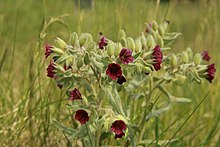Brown monk's herb
| Brown monk's herb | ||||||||||||
|---|---|---|---|---|---|---|---|---|---|---|---|---|

Brown monk's herb ( Nonea pulla ) |
||||||||||||
| Systematics | ||||||||||||
|
||||||||||||
| Scientific name | ||||||||||||
| Nonea pulla | ||||||||||||
| DC. |
The Brown Monkshood ( Nonea pulla ), and Dark Runzelnüsschen called or Napfkraut, is a flowering plant in the family of Borage Family (Boraginaceae).
description
Vegetative characteristics
The brown monk's herb grows as a perennial herbaceous plant and reaches heights of 20 to 50 centimeters. The stems are erect and often quite strongly knotted in the upper half; they are round and hollow.
The alternate and spirally arranged leaves are elongated to lanceolate with a length of 5 to 15 centimeters and a width of 1 to 2 centimeters. The leaves, which are gray-haired on both sides with short glandular hairs and bristles, have entire margins or are slightly cupped and without clearly recognizable side nerves. The lower leaves are narrowed like a stalk, the upper stalk encompassing.
Generative characteristics
The flowers are in rich, leafy, initially dense, later strongly elongated grape-shaped wraps. The flower stalks are initially short and upright, later elongated and curved.
The hermaphrodite flowers are five-fold with a double flower envelope . The sepals are fused to two thirds to three quarters of their length. The calyx is 6 to 8 millimeters long at the anthesis and 9 to 11 millimeters long at the fruiting time. The five calyx teeth are triangular. The 10 to 14 millimeter long corolla is dark brown-violet to black-purple, more rarely light brown or yellowish-white. The corolla tube is covered with throat scales reduced to small tufts of hair. The corolla lobes are semicircular. The stamens are very small. The scar is briefly bilobed.
The partial fruits (nuts) are about 4 millimeters long, obliquely egg-shaped and warty-wrinkled.
The number of chromosomes is 2n = 20.
ecology
The life form is hemicryptophytic , whereby the vegetation period extends from (April to) May to August.

Occurrence
The brown monk's herb is native to Eastern Europe and from the Middle East to Central Asia and also occurs to the west as far as Central Europe. It is a neophyte in southern northern Europe and southern Europe .
Typical locations for brown monk'sweed are dry grassland and field margins, and occasionally ruderal or semi-rudderal areas in the Colline and Pannonian regions. It thrives in dry meadow communities in Central Europe and is a character species of the Caucalidion lappulae association, but also occurs in associations of the Mesobromion or Geranion sanguinei associations.
Taxonomy and Botanical History
This species was already described by Johannes Thal in 1577 from the Harz region as "Buglossa sylvestris nigra" and later by John Ray as "Buglossum annuum pullo flore minimo vesicarium". The first valid publication took place in 1805 under the name Nonea pulla by Augustin Pyrame de Candolle . Synonyms of Nonea pulla DC. are: Nonea erecta Bernh. , Lycopsis taurica Ledeb. , Nonea taurica (Ledeb.) Ledeb. , Nonea rossica Steven , Lycopsis pulla L. nom. illegal. non Loefl. 1758, Anchusa pulla M.Bieb.
literature
- Manfred A. Fischer, Karl Oswald, Wolfgang Adler: Excursion flora for Austria, Liechtenstein and South Tyrol . 3rd, improved edition. State of Upper Austria, Biology Center of the Upper Austrian State Museums, Linz 2008, ISBN 978-3-85474-187-9 .
- Gustav Hegi: Illustrated flora of Central Europe. Pteridophyta, Spermatophyta . 2nd Edition. Volume V. Part 3: Angiospermae: Dicotyledones 3 (3) (Pirolaceae - Verbenaceae) . Carl Hanser and Paul Parey, Munich and Berlin / Hamburg 1966, ISBN 3-489-76020-4 , pp. 2206–2208 (unchanged reprint of the 1st edition from 1927 with addendum). (Sections Description, Distribution and Systematics)
Individual evidence
- ↑ a b c d Nonea pulla L. ex DC., Braunes Mönchskraut. In: FloraWeb.de.
- ↑ a b c d e f Gustav Hegi: Illustrated flora of Central Europe. Pteridophyta, Spermatophyta . 2nd Edition. Volume V. Part 3: Angiospermae: Dicotyledones 3 (3) (Pirolaceae - Verbenaceae) . Carl Hanser and Paul Parey, Munich and Berlin / Hamburg 1966, ISBN 3-489-76020-4 , pp. 2206–2208 (unchanged reprint of the 1st edition from 1927 with addendum).
- ↑ a b Erich Oberdorfer : Plant-sociological excursion flora for Germany and neighboring areas . With the collaboration of Angelika Schwabe and Theo Müller. 8th, heavily revised and expanded edition. Eugen Ulmer, Stuttgart (Hohenheim) 2001, ISBN 3-8001-3131-5 , pp. 785 .
Web links
- Nonea pulla at Tropicos.org. Missouri Botanical Garden, St. Louis, accessed February 12, 2016.
- Brown monk's herb . In: BiolFlor, the database of biological-ecological characteristics of the flora of Germany.
- Brown monk's herb In: Info Flora , the national data and information center for Swiss flora . Retrieved February 9, 2016.
- Distribution in the northern hemisphere from: Eric Hultén, Magnus Fries: Atlas of North European vascular plants. 1986, ISBN 3-87429-263-0 at Den virtuella floran. (Swedish)
- Thomas Meyer: Monk's herb data sheet with identification key and photos at Flora-de: Flora von Deutschland (old name of the website: Flowers in Swabia ).

